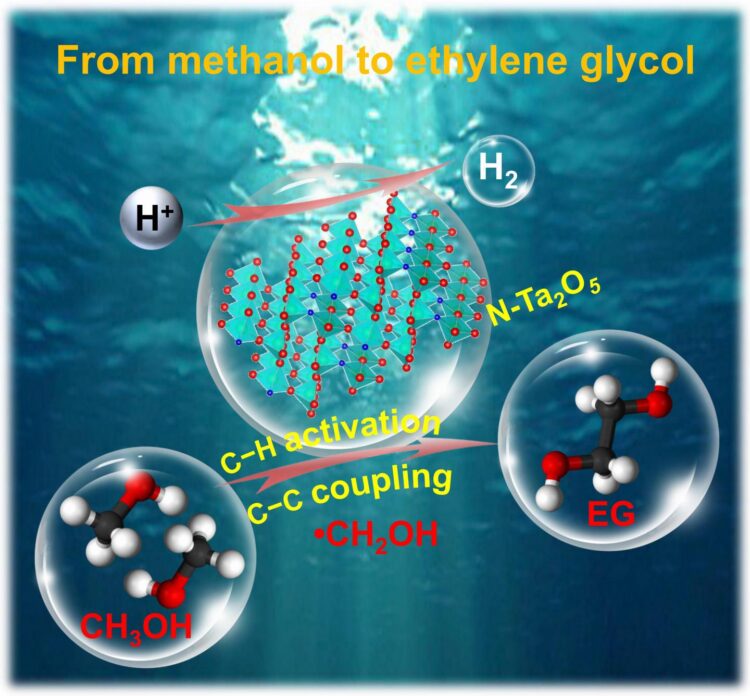Credit: Chinese Journal of Catalysis
The photochemistry of the future will spring up human industry without smoke, and bring a brighter civilization based on the utilization of solar energy instead of fossil energy. Photochemistry has been used in controlling many reaction processes, especially for the challenging reactions containing selective C-H activation and C-C coupling in chemical synthesis. It is of great interests that a “dream catalytic reaction” of direct coupling of methanol to ethylene glycol (2CH3OH ? HOCH2CH2OH + H2, denoted as MTEG) could be achieved through the solar energy-driven C-H activation and C-C coupling processes, and this MTEG reaction has not been achieved through thermocatalysis yet.
Ethylene glycol (EG) is an important monomer for the manufacture of polymers (e.g., poly(ethylene terephthalate), PET), and can also be used as antifreeze and fuel additive. The annual production of EG is more than 25 million tons, which is primarily produced from petroleum-derived ethylene industrially. Methanol is a clean platform chemical, which can not only traditionally produced from natural gas and coal, but also has been directly synthesized from biomass and CO2. Thus, the solar energy-driven MTEG route provides an alternative process for sustainable synthesis of EG and H2 from methanol directly with great attractions.
Although direct photocatalytic coupling of methanol to EG is highly attractive, the reported photocatalysts for this reaction are all metal sulfide semiconductors, which may suffer from photocorrosion and have low stability. Thus, the development of non-sul?de photocatalysts for efficient photocatalytic coupling of methanol to EG and H2 with high stability is urgent but extremely challenging.
Recently, a research team led by Prof. Ye Wang from Xiamen University and Yanshan University, China reported the first metal oxide photocatalyst, tantalum-based semiconductor, for preferential activation of C-H bond within methanol to form hydroxymethyl radical (* CH2OH) and subsequent C-C coupling to EG. Compared with other metal oxide photocatalysts, such as TiO2, ZnO, WO3, Nb2O5, tantalum oxide (Ta2O5) is unique in that it can realize the selective photocatalytic coupling of methanol to EG. The co-catalyst free nitrogen doped tantalum oxide (2%N-Ta2O5) shows an EG formation rate as high as 4.0 mmol/g/h, about 9 times higher than that of Ta2O5, with a selectivity higher than 70%. The high charge separation ability of nitrogen doped tantalum oxide plays a key role in its high activity for EG production. This catalyst also shows excellent stability longer than 160 h, which has not been achieved over the reported metal sulfide photocatalysts. Tantalum-based photocatalyst is an environmentally friendly and highly stable candidate for photocatalytic coupling of methanol to EG. The results were published in Chinese Journal of Catalysis.
###
About the Journal
Chinese Journal of Catalysis is co-sponsored by Dalian Institute of Chemical Physics, Chinese Academy of Sciences and Chinese Chemical Society, and it is currently published by Elsevier group. This monthly journal publishes in English timely contributions of original and rigorously reviewed manuscripts covering all areas of catalysis. The journal publishes Reviews, Accounts, Communications, Articles, Highlights, Perspectives, and Viewpoints of highly scientific values that help understanding and defining of new concepts in both fundamental issues and practical applications of catalysis. Chinese Journal of Catalysis ranks among the top six journals in Applied Chemistry with a current SCI impact factor of 6.146. The Editors-in-Chief are Profs. Can Li and Tao Zhang.
At Elsevier http://www.
Manuscript submission https:/
Media Contact
Fan He
[email protected]
Related Journal Article
http://dx.





